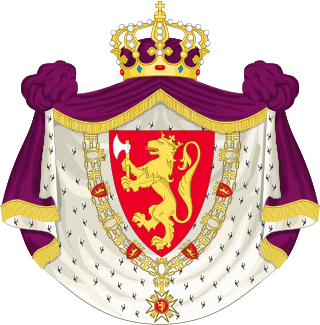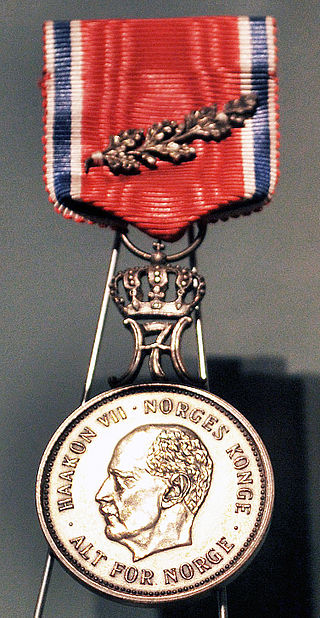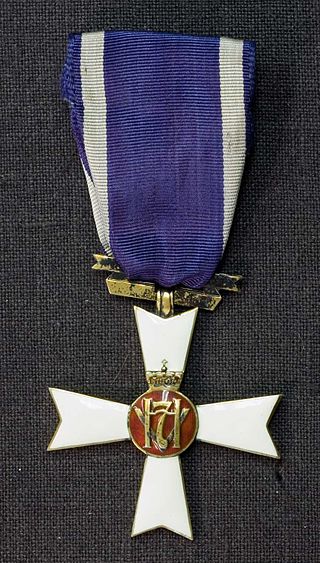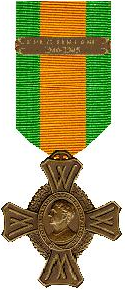
The Royal Norwegian Order of Saint Olav is a Norwegian order of chivalry instituted by King Oscar I on 21 August 1847. It is named after King Olav II, known to posterity as St. Olav.

Members of the Norwegian royal family are people related to King Harald V of Norway or former Norwegian monarchs who are royals and who hold royal titles. The term does not include non-royal relatives. The current family who holds the throne are members of the House of Glücksburg who ascended to the Norwegian throne after the election of Prince Carl of Denmark as King of Norway during the dissolution of the Swedish-Norwegian union in 1905.

HNoMS King Haakon VII was a Royal Norwegian Navy escort ship during World War II, named after King Haakon VII of Norway. She was given to the RNoN by the United States on 16 September 1942, in the presence of President Franklin D. Roosevelt and Norwegian Crown Princess Märtha.

The St. Olav's Medal and the St. Olav's Medal With Oak Branch were instituted by King Haakon VII of Norway on 17 March 1939. They are awarded in recognition of "outstanding services rendered in connection with the spreading of information about Norway abroad and for strengthening the bonds between expatriate Norwegians and their home country".

King Haakon VII's Freedom Cross was established in Norway on 18 May 1945. The medal is awarded to Norwegian or foreign military or civilian personnel for outstanding achievement in wartime. It is ranked fifth in the order of precedence in the Norwegian honours system.

The War Medal is a Norwegian war decoration for service during Second World War, and later for meritous service during war.

The King's Medal of Merit is a Norwegian award. It was instituted in 1908 to reward meritorious achievements in the fields of art, science, business, and public service. It is divided in two classes: gold and silver. The medal in gold is rewarded for extraordinary achievements of importance to the nation and society. The medal in silver may be awarded for lesser achievements. The medal is suspended from a ribbon in the colours of the Royal Standard of Norway.
The Civic Decoration is a civilian decoration of the Kingdom of Belgium. It was first established by royal decree on 21 July 1867 to reward exceptional acts of bravery, devotion or humanity. A further royal decree of 15 January 1885 extended the award to state civil servants for long service by a mere change of ribbon. The award statute was once again amended by royal decree in 1902 to include long service in the Civic Guard and firefighters, each with its distinctive ribbon.

St. Olav's Medal with Oak Branch is a Norwegian military award, which was instituted by King Haakon VII of Norway on 6 February 1942. In Norway, the medal is considered as a separate award from the civilian St. Olav's Medal.
Ragnar Leif Ulstein MM was a Norwegian journalist, writer and resistance member. He wrote several documentary books from the Second World War, including surveys of the SOE group Norwegian Independent Company 1, volunteers sailing from Norway to Scotland, refugee traffic from Norway to Sweden, and military intelligence in Norway.

H7 was the royal cypher of the Norwegian head of state, King Haakon VII, who reigned from 1905 to 1957. When Germany invaded Norway in 1940 as a part of World War II, the royal family fled the country and Haakon VII later spearheaded the Norwegian resistance in exile in the United Kingdom. H7 became one of several symbols used by the Norwegian populace to mark solidarity with and loyalty to the King, and adherence to the Norwegian resistance movement.
The Croix de guerre (French) or Oorlogskruis (Dutch) is a military decoration of the Kingdom of Belgium established by royal decree on 25 October 1915. It was primarily awarded for bravery or other military virtue on the battlefield. The award was reestablished on 20 July 1940 by the Belgian government in exile for recognition of bravery and military virtue during World War II. The post-1940 decoration could also be awarded to units that were cited. The decoration was again reestablished by royal decree on 3 April 1954 for award during future conflicts.

Haakon VII 70th Anniversary Medal is a Norwegian military award, which was instituted by King Haakon VII of Norway on 27 October 1942. It was awarded in recognition of military personnel who served in the Norwegian armed forces in Britain on the 70th birthday of Norwegian King Haakon VII. The medal ranks 33rd in the Norwegian decoration order of precedence.
King Christian X's Liberty Medal was a commemorative decoration awarded by King Christian X for special services to Denmark during World War II.

H.M. The King’s Commemorative Medal is a royal decoration of Norway. Established in 1906 by King Haakon VII, the medal is awarded to individuals for particularly meritorious service to the King. The medal is awarded in grades, gold and silver. The gold medal ranks 28th in the Norwegian order of wear just below the Antarctic Medal and above The Royal House Centenary Medal. The silver medal ranks 38th in the order of precedence below the King Olav V's 100th Anniversary Medal and above the Defence Service Medal.
The King Haakon VII 1905–1930 Jubilee Medal, also known as the King's Jubilee Medal, is a Norwegian award instituted in 1930 by Haakon VII of Norway in honor of the 25th anniversary of his accession to the throne. The medal has been conferred upon 397 people.
The King Haakon VII 1905–1955 Jubilee Medal, also known as the King's Jubilee Medal, is a Norwegian award instituted in November 1955 by Haakon VII of Norway in honor of the 50th anniversary of his accession to the throne. The medal ranks 32nd in the Norwegian decoration order of precedence.
The King Haakon VII Commemorative Medal of October 1, 1957 is a Norwegian award created to commemorate the deceased monarch on the occasion of his funeral. King Haakon's funeral took place on October 1, 1957. The medal ranks 30th in the Norwegian decoration order of precedence.
The Royal House Centennial Medal is a Norwegian award established by Harald V of Norway to commemorate the centennial of the Norwegian royal family. The day that it was established marks the hundredth anniversary of the day that Haakon VII arrived in Norway: November 25, 1905. The medal ranks 29th in the Norwegian decoration order of precedence.

The War Commemorative Cross is a military award of the Netherlands. The medal was established to commemorate service to the Kingdom of the Netherlands during World War II. The medal was established on 16 March 1944 by royal decree of Queen Wilhelmina.










